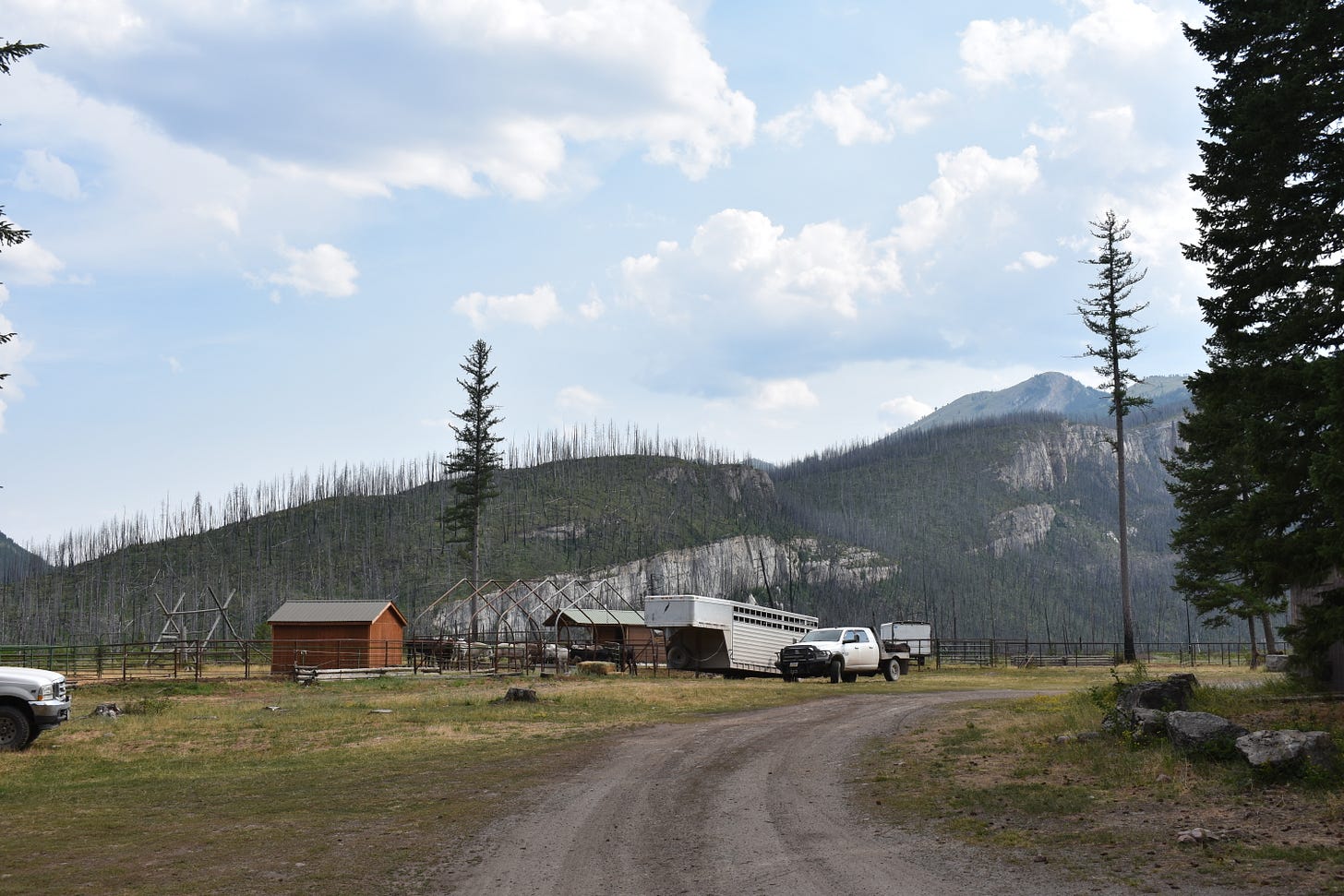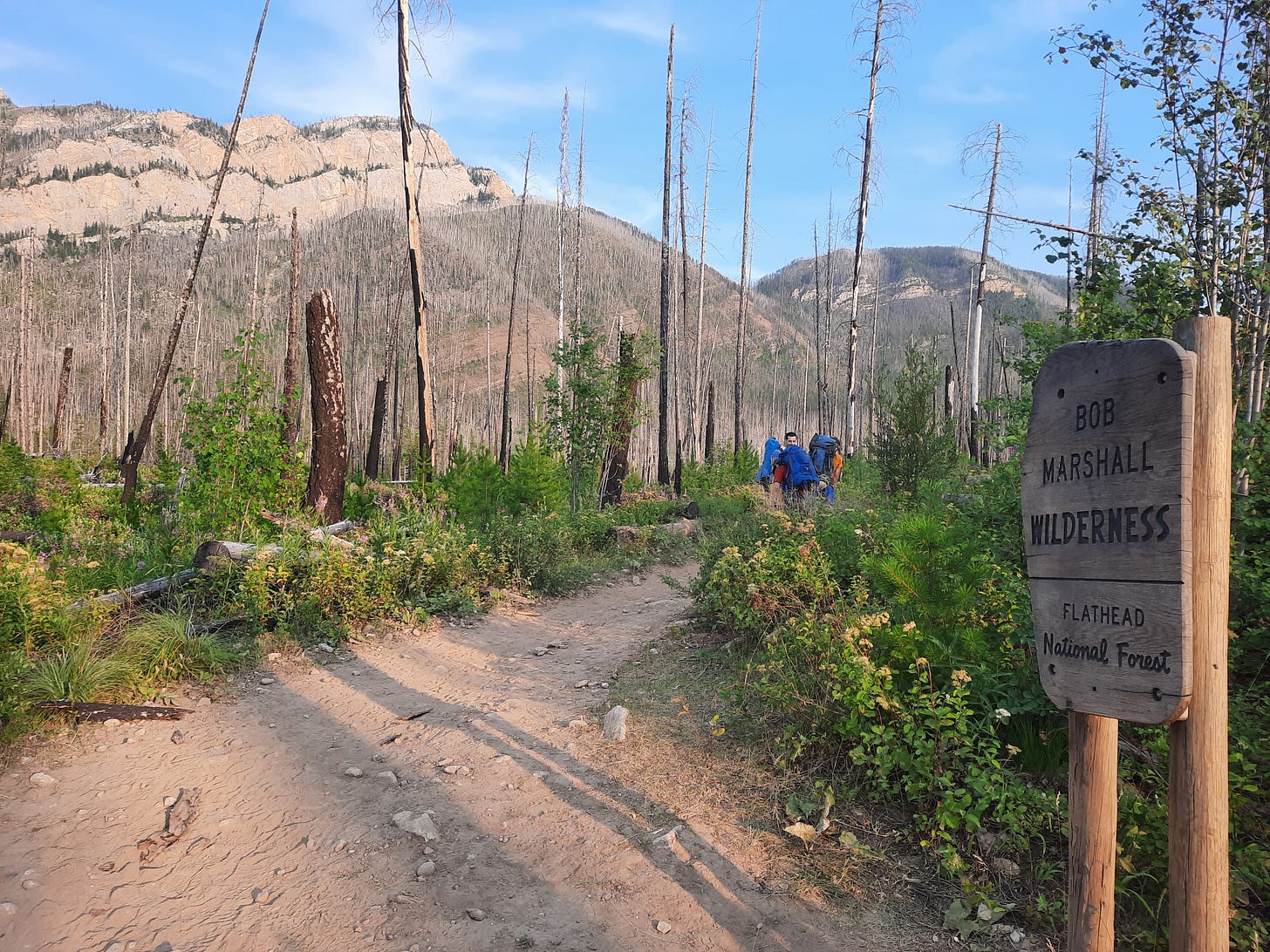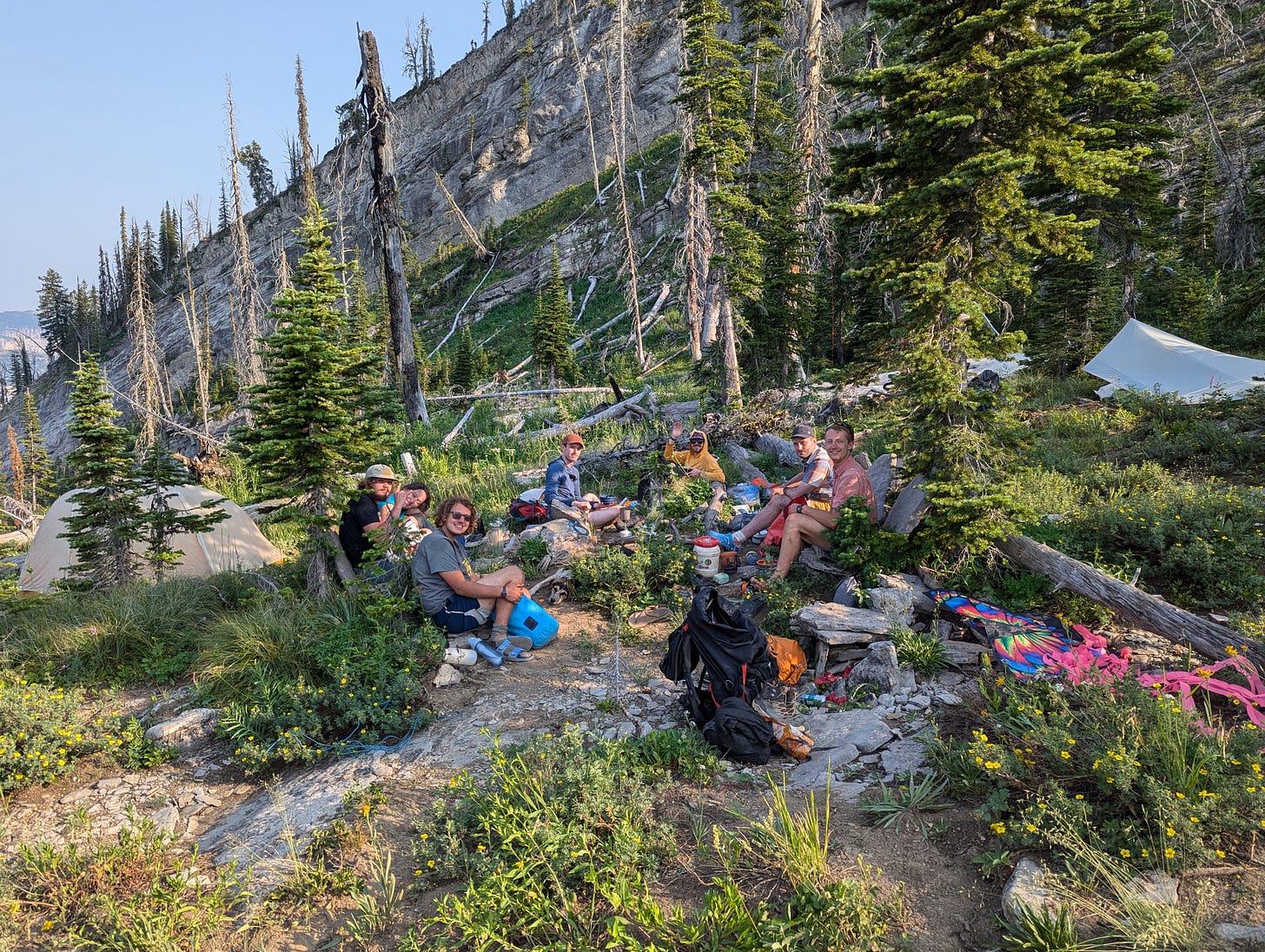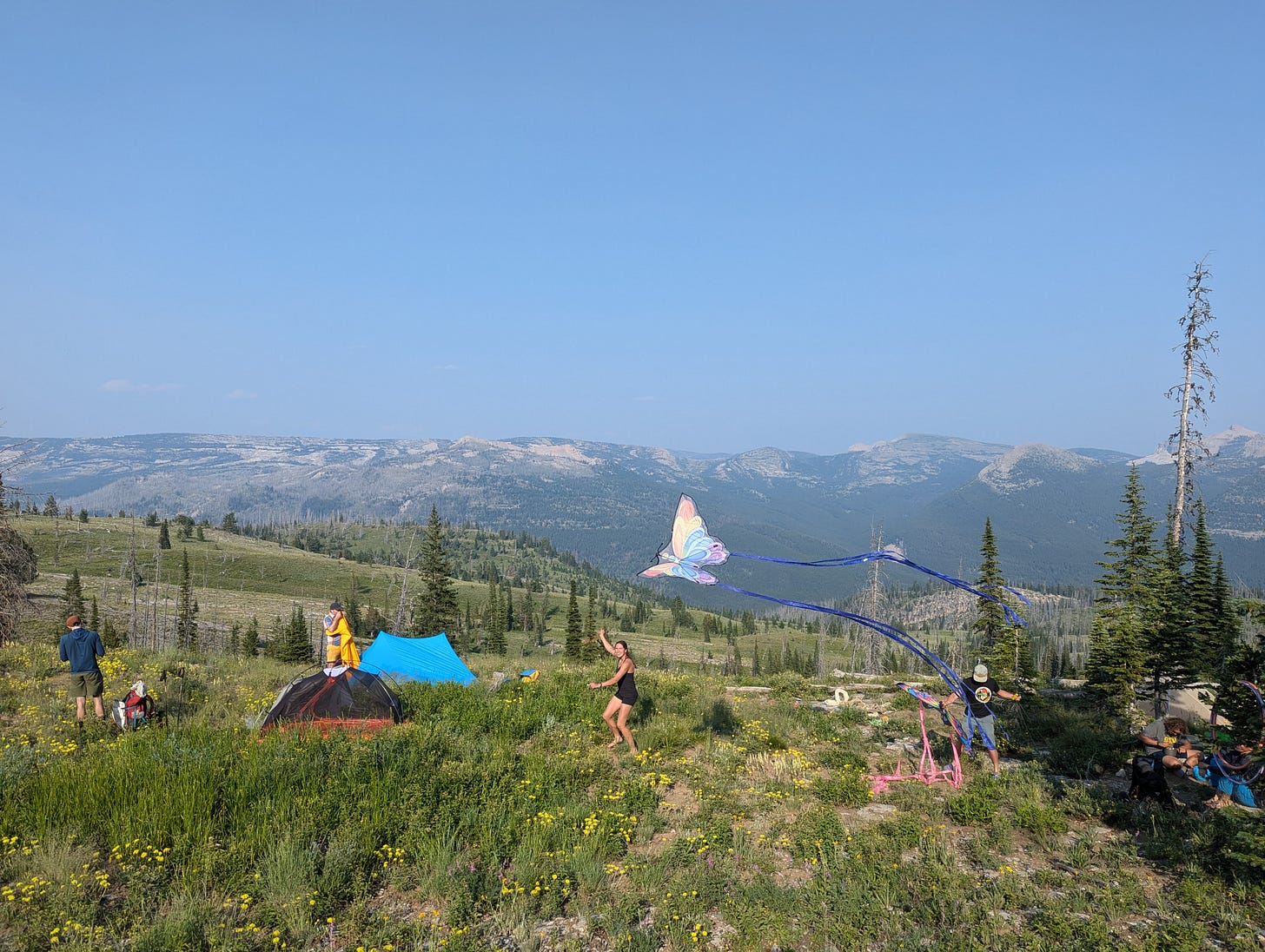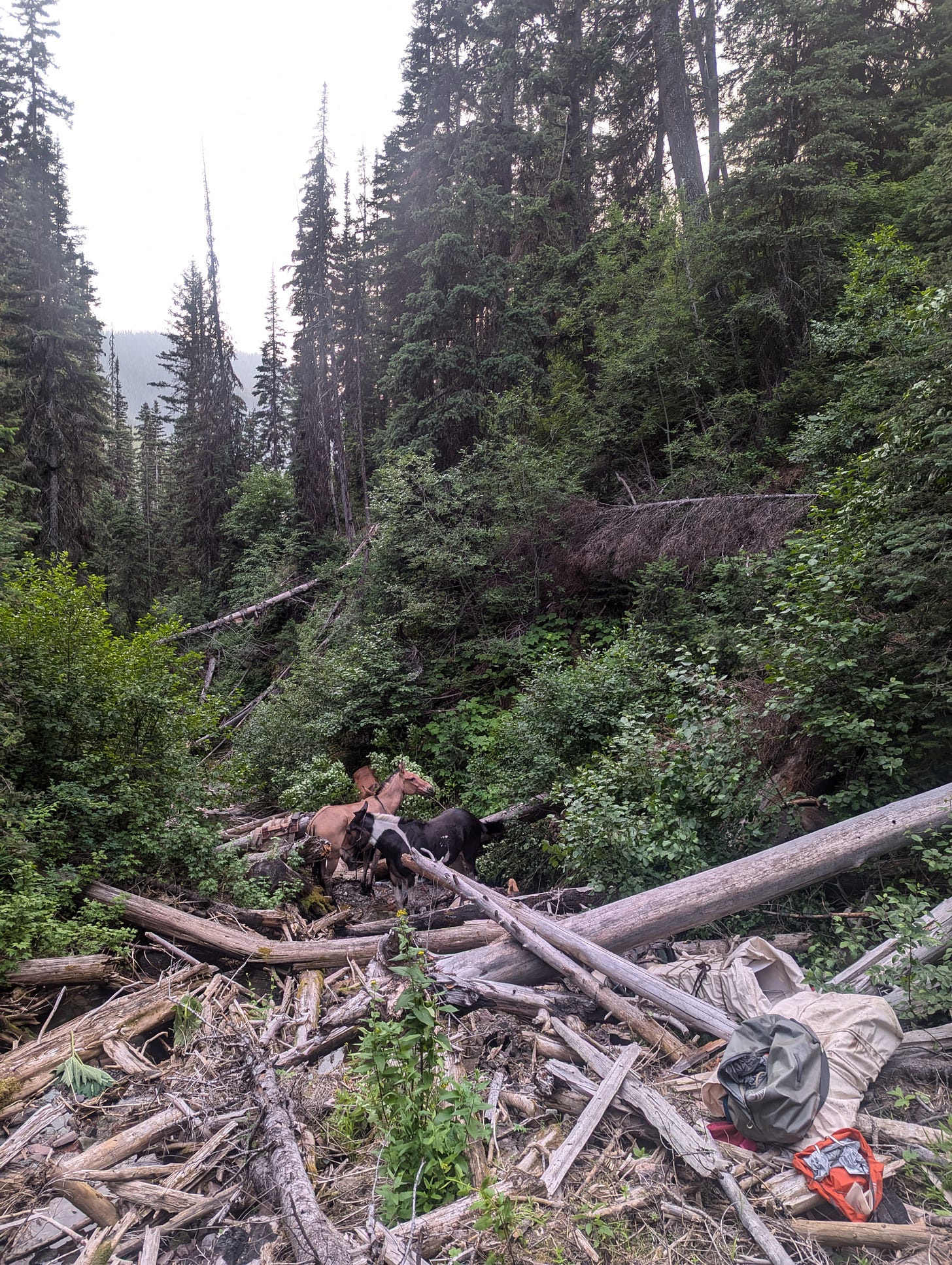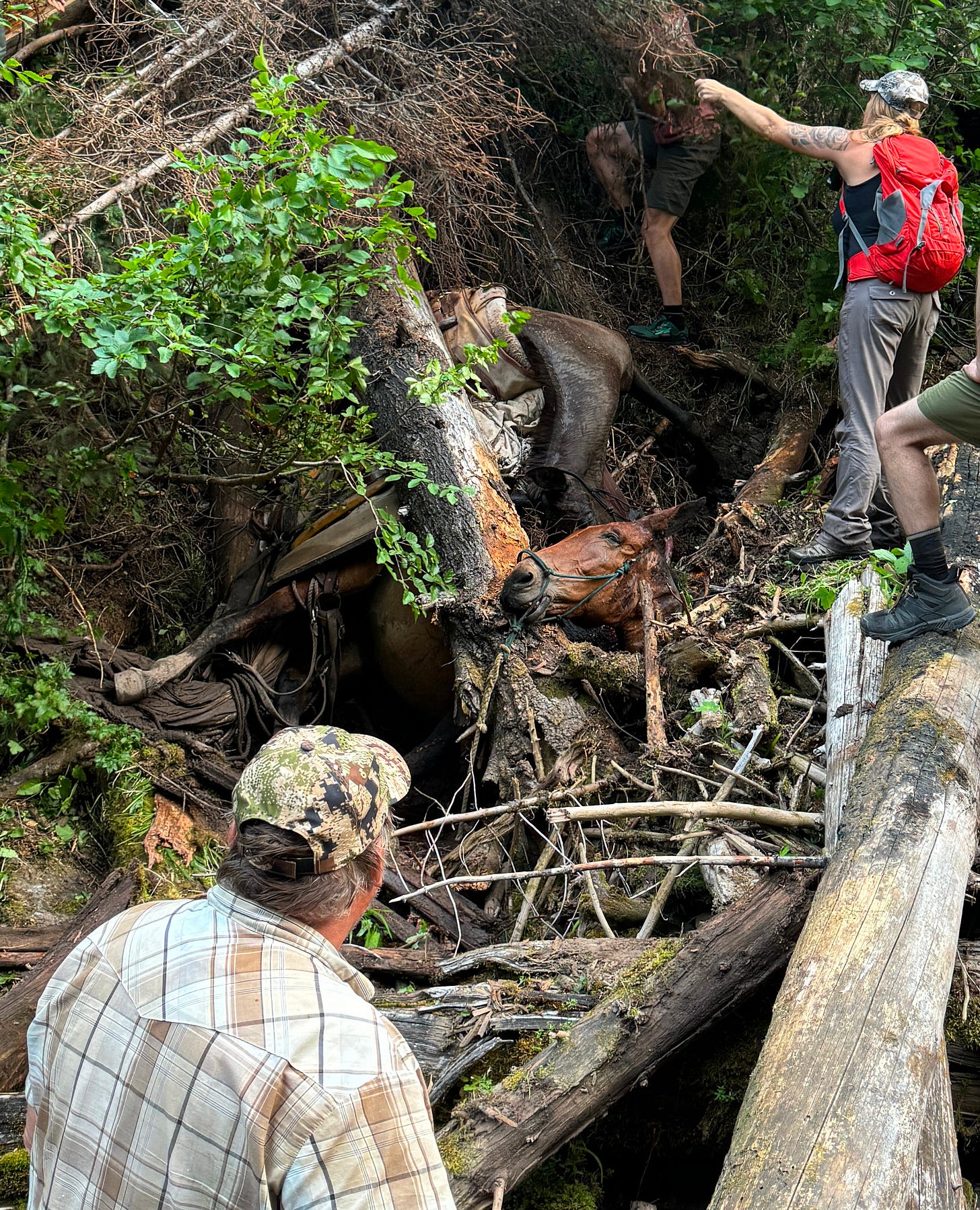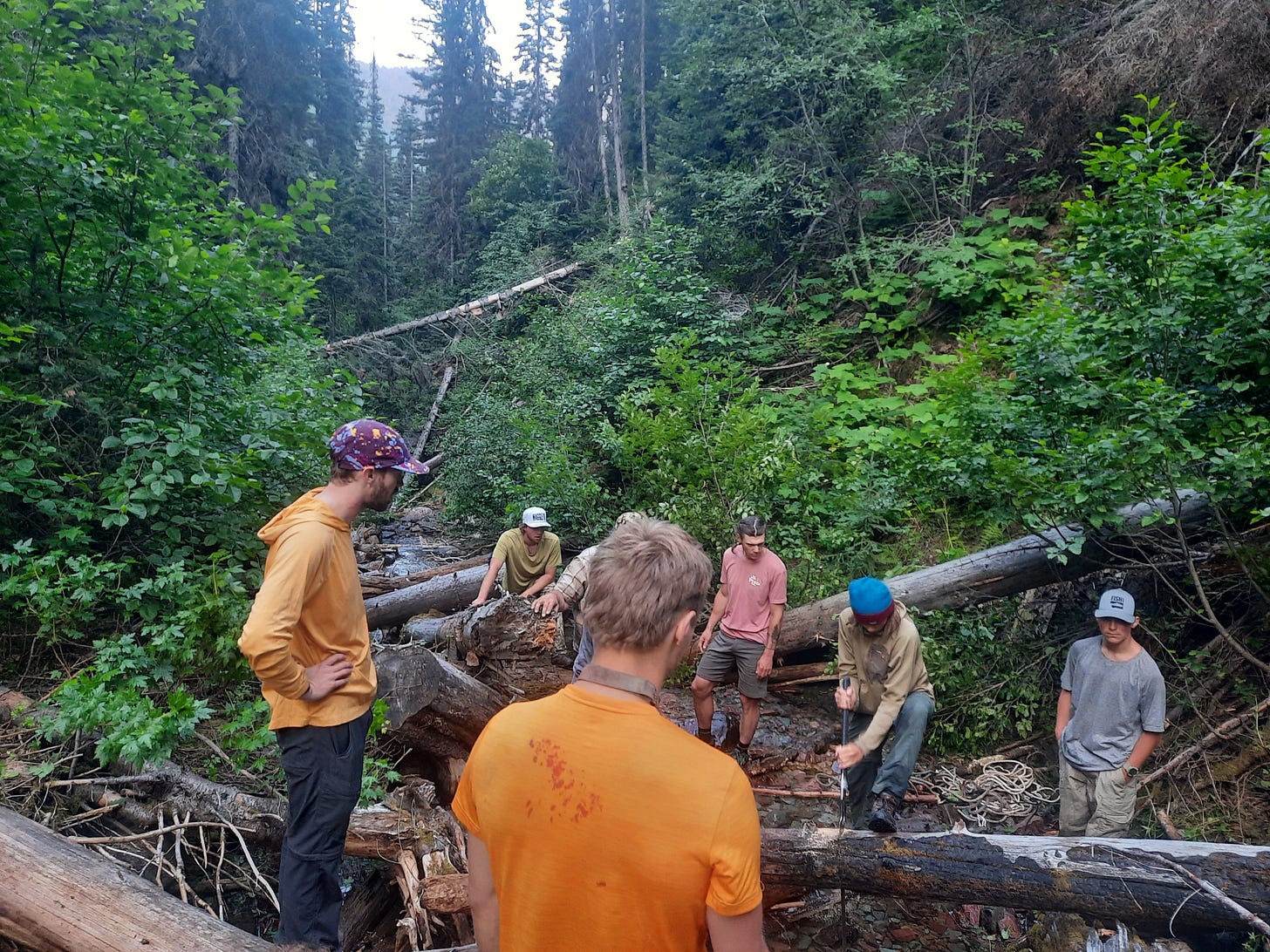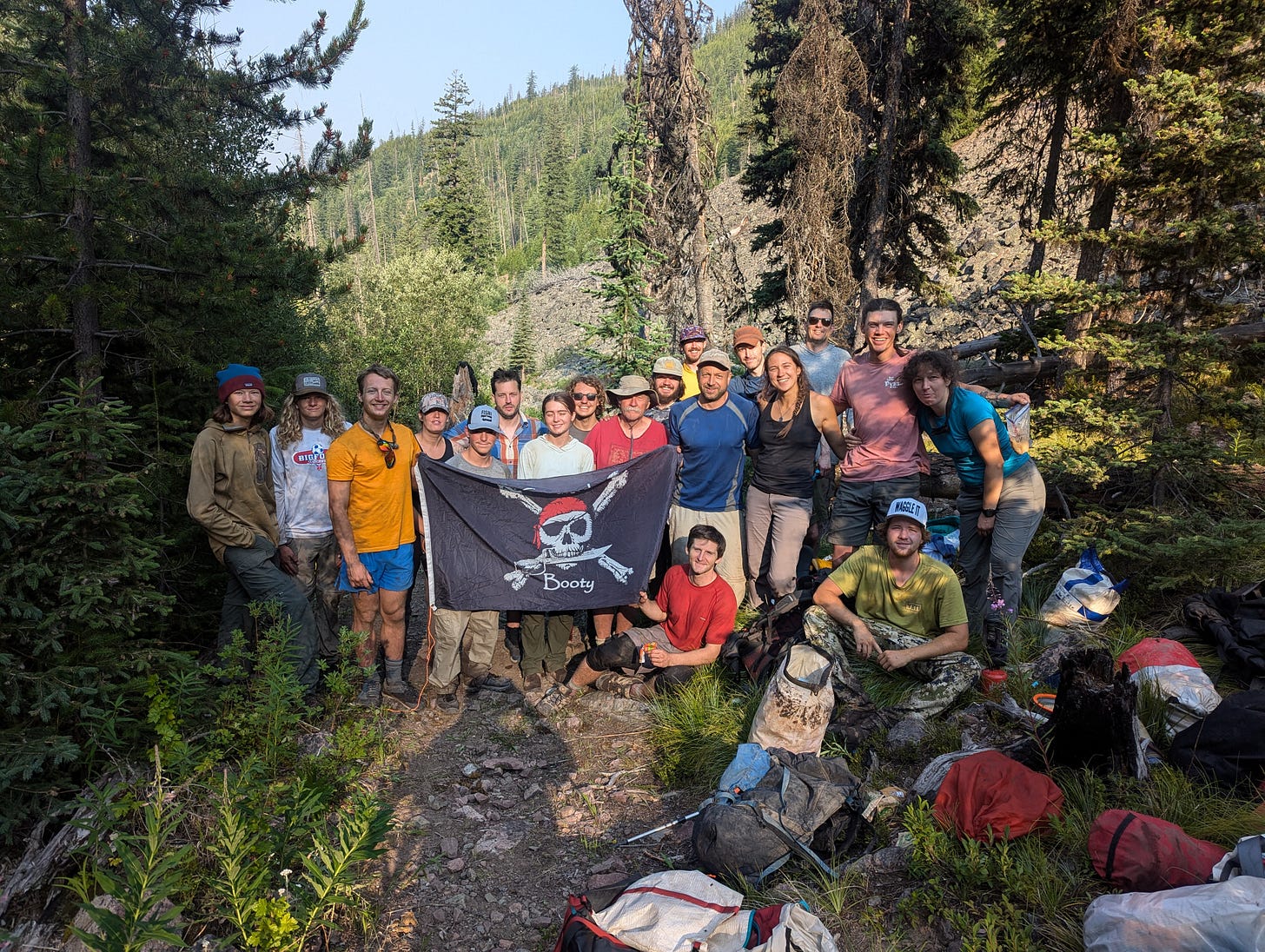Tears of the Turtle Cave, 2024 expedition, part 1
The deepest cave in the US gets even deeper! Many mishaps along the way.
This series of posts will describe the 2 weeks I spent on an expedition to continue exploration at the bottom of Tears of the Turtle Cave, the deepest cave in the US. These 2 weeks were the second half of my month of caving I did early July through early August 2024. The first half I was on Prince of Wales Island, Alaska, as I described in my previous post. This is the first post in a series; here I describe everything that happened before my team entered the cave, which was quite a lot!
Tears of the Turtle Cave, or just "Tears" as we call it (this should give you a sense of what the cave is like), is remote in many ways. The entrance is a 22 mile hike from the nearest road, deep in the Bob Marshall Wilderness area (“the Bob”) in northwestern Montana. And that road is 3 hours of dirt road driving into the mountains of Montana from the nearest town. Once you get to the entrance, the real remoteness begins: the bottom of the cave, the frontier at which exploration is ongoing, is so many hours of hard, grueling travel to get to from the entrance that we have established a camp partway down so cavers can sleep near the bottom. This lets us live in the cave for days at a time while we conduct the hard yet glorious work of exploration. And this year, for the first time ever in a US cave, we established a camp 2 beyond camp 1, close to the current bottom of the cave, as the frontier of exploration had been pushed to many hours of hard travel beyond camp 1.
This expedition, the first return to the cave in 2 years since the summer 2022 expedition that I was on, was chaotic, but wildly successful. Every day it seemed like something major went wrong that changed the plans for the whole rest of the trip, yet somehow our sequence of last-minute changed plans ended up working well and enabling some exciting and successful exploration. Read on to hear about all that went wrong and all that went so, so right!
Friday, July 19
I woke up at 5:30am in Thorne Bay, a small town on Prince of Wales Island, a large temperate rainforest island off the coast of southern Alaska. I quickly hopped in the car, and my friend Christian, whose house I was staying at that week, drove me to a ferry terminal in Hollis, Alaska. Hollis is only 15 miles away, but a rugged mountain range separating Thorne Bay and Hollis forces the route to take a circuitous, hour-and-15-minute course, crossing between the east and west sides of the island twice. At Hollis, I boarded a ferry that took me on a leisurely 3 hour scenic ride to Ketchikan, a small city on Revillagigedo Island, just to the east of Prince of Wales Island. From there I took another short ferry to the airport. From the Ketchikan airport, I flew to Seattle then to Kalispell, Montana, landing after just over 12 hours of travel. At the Kalispell airport I was greeted by Hans Bodenhamer, a local caver and veteran Bob Marshall Wilderness caver, and Derek Von Nieda, a young east coast caver. We went back to Hans' house to spend the night before the expedition officially began the next day. When we got to Hans' house, Tommy Cleckner, a Denver-based caver that I had caved with in Tears back in 2022 and was looking forward to caving with again, had just arrived. We were supposed to have 2 more people already at that time, which brings me to the first incident that threw a wrench in our plans for the expedition: the CrowdStrike outage.
That day, CrowdStrike, a cybersecurity company, sent out a bad software update to some of its security software that crashed Windows computers all over the world. All sorts of industries that used computers, such as hospitals, banks, and internet services, went down, but airlines were affected particularly severely. United, Delta, and American Airlines cancelled many flights that Friday and that weekend. Thankfully, my Alaska Airlines flight was unaffected. But not everyone on the expedition was so lucky. Jason Ballensky, the expedition leader whose support and planning we needed to make everything happen, had his flight get cancelled. We would be pretty screwed without his leadership, but thankfully he was able to find another flight on a different airline from San Diego the next day, the day we were scheduled to start hiking into the Bob. Eric Pekley had his flight cancelled and was unable to find another flight that would get him here in time, so he had to bail on the whole trip. Losing Eric was a real bummer—I caved with him in the 2022 expedition, and was looking forward to caving with him again, as he was scheduled to be on the first exploration trip with me pushing the bottom of the cave, along with Tommy Cleckner and Dustin Kisner. Without Eric, we would have to swap in someone else to be the fourth person on that first exploration trip.
Saturday, July 20: convene in Kalispell, start hiking in to basecamp
Everyone else on the trip arrived without incident that morning, as no one except Jason, Eric, and myself were flying in. I spent the morning shopping for 2 weeks worth of food and organizing my bags, as all my caving and camping gear was scattered in my checked and carry-on luggage. I already had the main portion of all my dinner and breakfast meals, Dinner Mix, packed in drums and ready to go, but I needed to get 2 weeks worth of day food and various add-ins for the dinner mix. Dinner mix is a dehydrated, ultralight food mix that I make for backpacking/cave camping trips where I need to carry lots of food a long ways. My recipe, which is a modified version of the dinner mix they make at the Cheve cave expeditions in Mexico, is:
Instant mashed potatoes
Dehydrated cooked beans
Chia seeds
Nuts (currently cashews, walnuts, and pepitas)
Textured vegetable protein
To turn it into a meal, you add hot water to it, and all the dried ingredients rehydrate and greatly expand in volume. The nuts add a nice crunch, so it’s not entirely wet slop. I also add a generous quantity of butter for taste and nutrition, and typically some other flavorful add-ins like sun dried tomatoes, bouillon power, Parmesan cheese powder, or various spice mixes.
I ate Dinner Mix for every breakfast and dinner meal over the 2 weeks, with the exception of 3 meals where I ate oatmeal. All the remaining food for during the days, when I was away from camp, I had to purchase in Columbia Falls (the town where Hans lives, just outside Kalispell). Highlights from my grocery shopping for 2 weeks of expedition food include:
5 pounds of cheese
2 pounds of butter
1.25 pounds of cooked bacon bits (I actually brought these from Albuquerque, where I bought that at Costco)
About 20 candy bars of various types (Snickers, Hershey’s, etc)
I bought $120 worth of food. Not bad for 2 weeks of day food during a time when I was going to be eating a LOT. I spent the rest of the morning packing my personal backpack that I would carry into surface basecamp, and other bags full of my food and caving gear that we would put on the mules that we were paying to haul most of our gear into the Bob.
I had all my bags packed by late morning, and everyone had arrived except our Jason, whose flight was delayed til 2:15pm that afternoon. We wanted to leave town by 2pm in order to get to the trailhead by 6pm, when we were supposed to meet the mule packers. We decided to leave for the trailhead without our dear leader Jason, except for one person who would stay behind to pick him up from the airport. I rode with a driver Jason hired to haul all our gear from Columbia Falls to the trailhead. We thought we would need an extra car to get all of our stuff to the trailhead, but after we lost Eric, we had enough car space for all of us and our gear. But the driver was already here, so we put some gear in his truck and I accompanied him to the trailhead.
It’s about 3 hours from Columbia Falls to the Meadow Creek Trailhead, where we were to meet the packers who would haul in most of our gear using mules. The drive is quite scenic. After passing the Hungry Horse Dam, you spend the next 2 hours right alongside the crystal clear turquoise water of the Hungry Horse Reservoir. After the reservoir ends, a dirt road takes you another hour upstream along the South Fork Flathead River until you get to the trailhead and the adjacent packer camp.
We had way too much stuff to carry 2 weeks worth of food; personal caving gear including heavy cave suits, metal vertical gear, and many warm layers, and group caving gear including survey equipment, cave camping supplies, and hundreds of feet of rope. So mules or some other form of pack animal were a practical necessity. I got there first and greeted the packers, who were just getting back from with some packrafters they hauled for. I unloaded all the gear from the driver’s truck, got 2 piles going—one for stuff we were getting packed in, and one for personal backpacking stuff we would carry in for the 2 day approach to basecamp.
The others arrived shortly after me, including Jason who finally made it after his cancelled original flight. After giving the packers all of our gear to be packed in, and packing the rest in our backpacks, we set off for basecamp, a measly 21 miles away. The plan was to hike in about a third of the way tonight and the rest of the way tomorrow, Sunday. On Monday, the mules would bring our gear to Pagoda Pass, 20 miles from the trailhead at the end of the portion of the approach hike that follows established trail. From there, we would shuttle gear in multiple loads the last mile to basecamp. This last mile is off-trail, on terrain that the mules can’t handle.
We started hiking at 7:15pm. This was later than our planned start time of 6pm, although none of us minded, due to the second major complication of the expedition after the CrowdStrike fiasco: record high heat. It hit 98 in Kalispell that day and stayed in the high 90s the next few days when we would be backpacking and shuttling gear. The trailhead was only 1000 ft higher so not much cooler. Sunset was at 9:30pm, so it had hardly cooled down at all when we started hiking at 7:15pm.
The first half of the approach follows the South Fork Flathead River upstream on a flat, dry, dusty trail. Most of the trees on this trail have burned recently, so there was no shade for the first few hours of our hiking that night while we roasted in the strong, high elevation sun. We power walked along the trail, our bags only moderately heavy, as we only needed to carry 3 days worth of food until our planned rendezvous with the mules at Pagoda Pass on Monday. We were all relieved when the sun dipped below the mountain tops across the Flathead River and we could hike without being scorched.
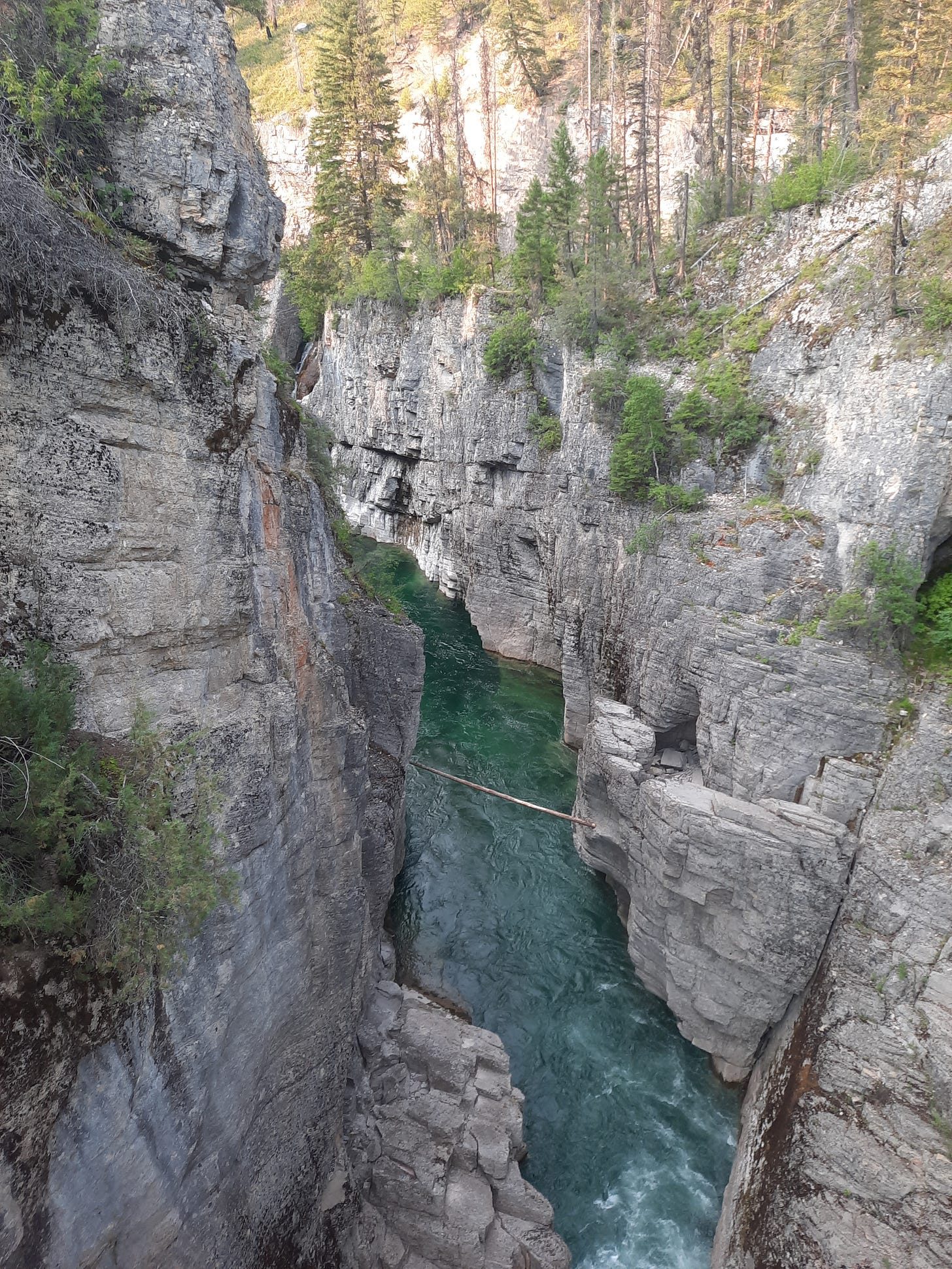
At 10:30pm, after an hour of blissful post-sunset hiking, we arrived at a good spot to camp just past the Black Bear Creek trail. This was 8 miles from the trailhead. We stopped here for the night and set up camp, which was pretty minimalist for most people. I didn’t even bring a tent on this expedition, just my hammock rain fly that I would use as a lightweight ceiling-only tarp shelter, which I didn’t even set up that night cause it wasn’t gonna rain. I like to cowboy camp with no tent/shelter when the weather allows. It certainly didn’t allow in the temperate rainforest that is Prince of Wales Island, Alaska. So I took this opportunity to fall asleep under the stars.
The campsite was immediately adjacent to the river, which was nice. We were all treated to a faint sound of lightly running water as white noise while falling asleep. I took a quick skinny dip in the river before heading to bed, as I had a lot of sweat to wash off and I hadn’t showered since before the previous caving day before leaving Thorne Bay. The river water was surprisingly not that cold; it merely cooled me down comfortably after a short but still scorching evening in the heat.
Sunday, July 21: onwards to basecamp
We woke up with the sun and made a point to pack up camp quickly so we could get started hiking before the heat became too intense. Right as we left camp, we ran into Hans and his group of high schoolers. Hans lives nearby in Columbia Falls and I stayed in his house Friday night. He teaches at the local high school, and every summer he brings some students in the school’s caving club out into the Bob Marshall Wilderness for a week long caving and backpacking trip. This year they were tagging along with us. They would check out some of the easier caves near Tears of the Turtle, and maybe some of them would check out the top of Tears if they felt like it. Anyways, they had started their hike from the at 3am that day to beat the heat. We joined them then overtook them, continuing upstream along the Flathead River,
After 4 more miles along the Flathead, it was time to turn to the east up the Helen Creek trail. Here the trail leaves the gentle flats of the river and begins a gradual but long climb up the Helen Creek drainage. The bottom of the Helen Creek drainage is wet and vegetated, with plenty of tree cover for shade. The greenery and decent, if intermittent, shade provided a nice contrast from the dry, dusty trail on the banks above the Flathead River, where the vegetation was thoroughly burned and there were no trees for shade.

The trail crisscrossed the creek as we climbed up the drainage, and we enjoyed frequent water stops at these crossings. As we made it up higher in the drainage, we entered more recently burned terrain and we lost our precious tree cover. By now we were in the midst of the midday heat and we were roasting again. Now when we encountered water, I made sure to scoop up a few liters and dump them all over me to cool off. The water in these small mountain streams was quite cold, unlike the lukewarm Flathead River, so these little bursts of water I would dump on myself were quite effective in cooling me off and keeping the high-90’s heat and intense high-elevation sun at bay.
We passed the last water source before basecamp at 12:30pm, when the sun was blazing as strong as it would that day. I filled up several liters of cold mountain stream water, dumped several more liters all over myself, and powered up the steepest section of trail ahead to Pagoda Pass. At this point the heat was taking a lot out of me, and I was ready to be done exerting myself for the day. The intense sunny dry heat felt kind of nice the day before, mainly as a contrast against the rainy, cold, soggy rainforest that I just spent 2 weeks in in Alaska. But by today I was already over it. The heat was draining me and I was ready to be out of it.
After last water, Jason and Tommy and I pulled ahead of the rest of the group and gunned it to basecamp. We hit Pagoda pass one very hot hour and a half later, at 2pm. There we left the established trail, quested up to a saddle separating our current drainage from another, then descended down the trail-less drainage on the other side. Camp was in this drainage. The final descent from the saddle towards basecamp takes you through a pleasant, gently sloping, grassy meadow teeming with wildflowers. For a moment we forgot about all the heat, and all the effort it took to get here, as we were finally going downhill through a friendly, idyllic meadow with grand alpine scenery all around us. Sublime.
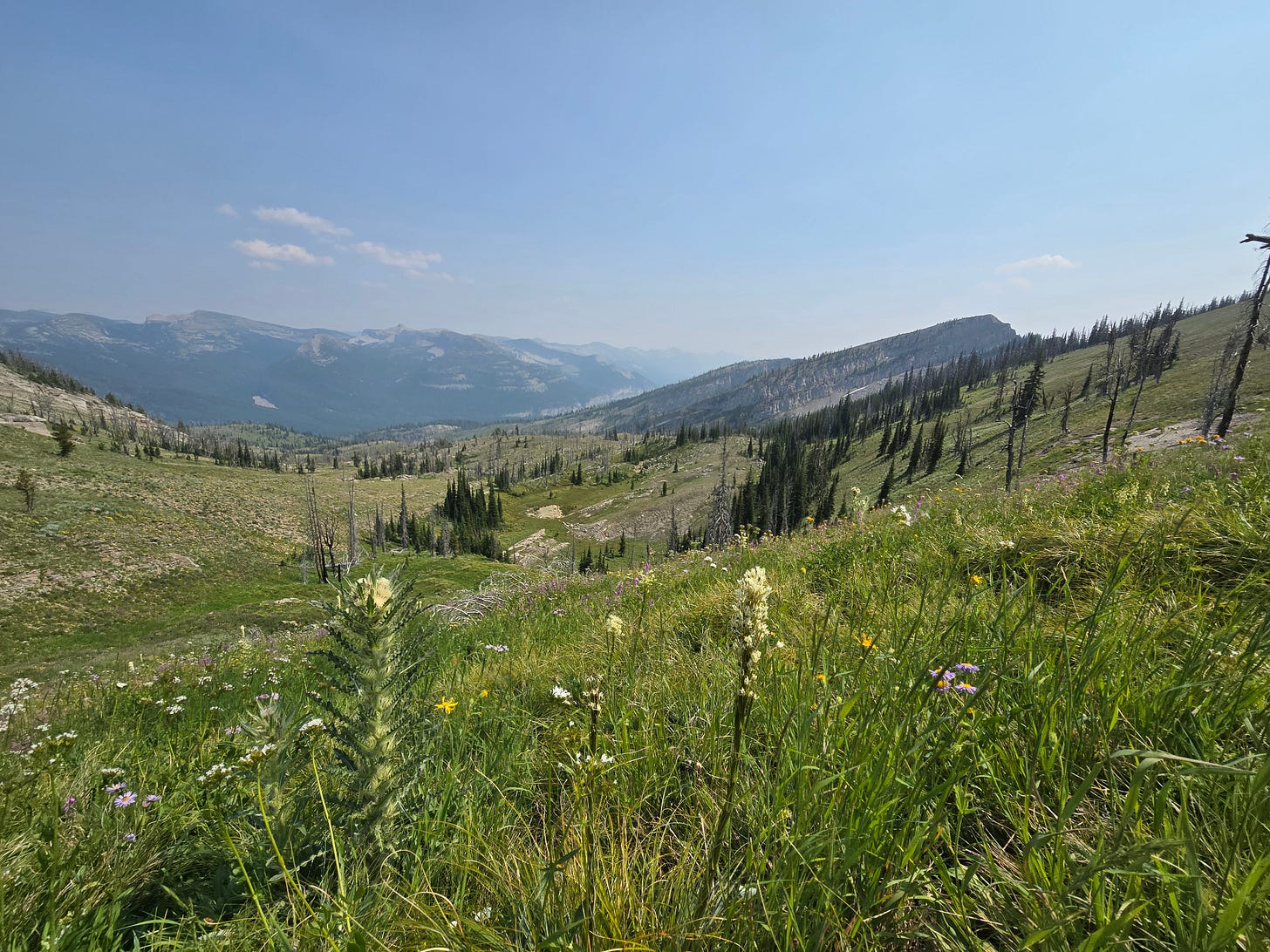

When we arrived at basecamp at 2:45pm, Alex Lambie was already there. Earlier that day he hiked over from Silvertip, another caving area to the north where a parallel expedition was taking place, Him, and later Dustin Kisner and Matteo Bucalossi, joined us at Tears of the Turtle in the middle of their Silvertip trip. Lambie took the standard route from Silvertip to Tears, while Dustin and Matteo opted for a more roundabout, scenic route, so Lambie got there first. I had never met Lambie before, so we chatted a bit before I began setting up my camp spot. I had heard Lambie described as extremely fun-loving and lighthearted and silly while also highly competent, and my initial impressions matched that description. I could tell we would get along well.
As the rest of the crew trickled in, I set up my humble camp spot. After looking around a bit, I settled on the same spot I used 2 years ago. Then I had my hammock. This year I went even lighter and only brought my hammock kit’s rain fly as a tarp shelter in case of rain. Once I had my rain fly rigged where I liked it, I terraformed a flat spot beneath it, blew up my sleeping pad, and laid out my ground sheet and quilt. With my quick and easy camp setup done, I was free to spend the rest of the afternoon lounging around and resting up before the intense multi-day bout of effort that was about to ensue.
That afternoon, Sam Marks broke out one of her signature surprise items. She likes to bring fun novelty items on caving trips—you may recall that on a Silent River Cave trip in the Grand Canyon earlier this year, she brought fancy ties for everyone to don and some small wine boxes and threw everyone a little fancy party. This time she brought kites! Several colorful butterfly-shaped ones. We amused ourselves that afternoon (and on several other days) flying kites in the gentle breeze.
Monday, July 22: meeting the mule packers at Pagoda Pass, allegedly…
Today was our day to meet the mule packers at Pagoda Pass to get the rest of our supplies and shuttle them in several loads across the final off-trail stretch to basecamp. The agreed-upon meeting time was noon, although we planned on getting to the pass early in case the packers made good time. After a leisurely morning, including a big breakfast to fuel our upcoming portering task, we made it to the pass at 11am. No one was there yet, so we gladly took some time to lounge around in the shade while we waited for the packers to show up. It was hot and the sun was beating down on us again, so even the easy (but uphill) off-trail mile from basecamp to Pagoda Pass with no loads took something out of me. It was going to be a lot harder doing this fully loaded with supplies, multiple times, in the more intense afternoon heat, so we savored some more nap time while we waited for the mules.
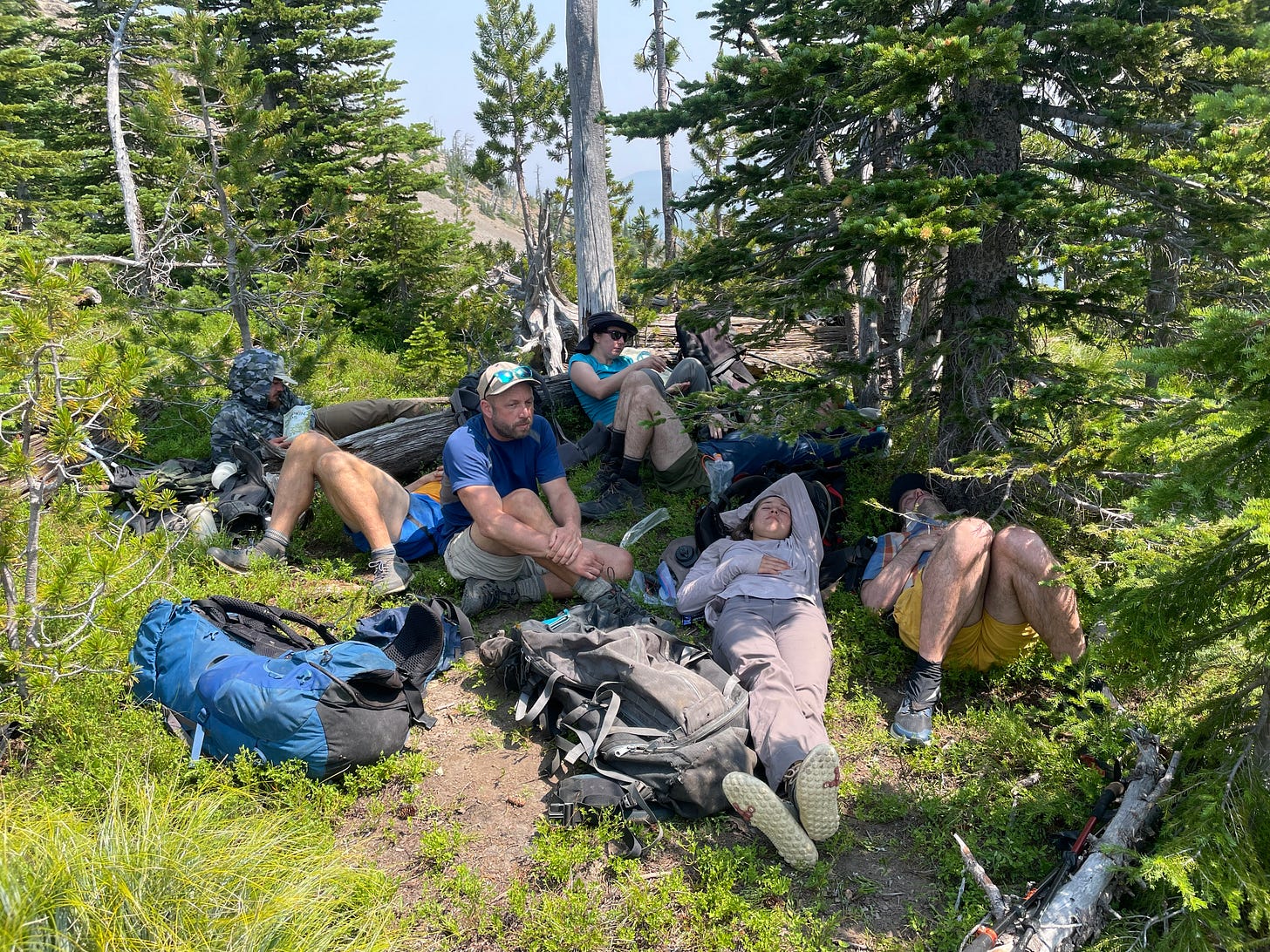
Noon passed with no sign of the mules. We waited for several more hours, not moving much from our nap spots except to shift around following the shade as the sun moved around in the sky. Eventually we started losing people at the pass, as some of us started heading back to camp for lack of water or food. I finally cracked and left for camp when I started getting hungry around 3:30pm. I didn’t bring any food, and little water, to the pass, as I expected to quickly grab a load of gear from the mules and take it back to camp.
Irina and I took a scenic route back to camp then. Instead of going off trail right at Pagoda Pass, we followed the Helen Creek trail down the Pagoda Creek drainage a ways before breaking off trail and traversing much lower towards camp. This was the old route they took to basecamp when they first started caving at Turtlehead Mountain. This route had no elevation gain, but it was longer (took an hour) and had more bushwhacking, so the other route is clearly better. But it was nice to take a different route since we had nothing but time.
Eventually everyone else including Jason made it back to basecamp after a few more hours waiting at the pass. Right now we were all in wait-and-see-what-happens mode, in no particular rush to do anything other than wait for the mules. And dissipate heat by not doing anything—the heat was definitely making some of us, including me, kind of lazy. But we knew this mode couldn’t last long. We had already lost one day of caving, as one team was supposed to enter the cave this afternoon to set up camp 1 (“Mud Camp”) in the cave right after getting their gear off the mules. But that was not gonna happen, as no one had any caving gear on them. We had all spent lots of resources (time off, money for plane tickets, etc) to get here, and we didn’t want to waste any of the precious 2 weeks we had here.
There was another reason this mode couldn’t last long. We didn’t have much food. The plan was to only carry 3 days of food to basecamp, and have the rest of our food for the 2 weeks delivered by the mules. Most of us took a little more food than this. But not a lot more. Most people could only last an extra day or so. I, for one, brought tons of extra food—I brought a 6 liter Darren Drum of dinner mix that had 20+ meals worth of food in it, for no other reason than it was already packed in the drum when I flew to Kalispell and I didn’t want to repack it into smaller containers to save food weight. I also brought my 5 pounds of cheese and 2 pounds of butter, so I could keep them fresher by putting them in cold mountain streams at night, instead of having them sit around on the mules in the heat. So I had plenty of extra food to share with others, just incidentally, not because I was planning for any unforeseen circumstances like the current ones. That night I shared some of my dinner mix and cheese with those who were running low on food.
At 6:30pm, Jason announced that it was time for him to leave basecamp and go investigate what was going on with the mule packers. The trailhead was 21 miles away, so he might be gone for quite some time. He took one of the inReaches (satellite messaging devices) and left one with us so he could communicate whatever he found. He packed up his tent and camping stuff, as he could be gone for more than the evening if the issue was all the way at the trailhead, 21 miles away. Jason insisted that no one else go with him, as that would just mean more people hiking unnecessary miles and wasting energy. So we all stayed at camp that night, lounging around and frequently checking the inReach for updates.
At 9pm, while we all surrounded the campfire, the inReach lit up. Pete opened it up and read it aloud as everyone crowded around him with nervous anticipation. The message read…wait for it…
Please confirm that you heard the plan.
Okay, anticlimactic. inReach messages have long delays and can sometimes come out of order. So we knew that this meant there was another message incoming with a status update that would tell us some sort of plan. We returned to lounging around by the fire, even more full of nervous anticipation than before. Several minutes later, the first message came through. He said that there was a “terrible wreck” halfway down the Helen Creek trail, and requested that we arrive the following day bright and early at 6am to fix it. It would take all day, but no longer than a full day, so he instructed us to not bring camp gear. This terrible wreck was the third major complication of the expedition, and the most serious so far.
We estimated that halfway down the Helen Creek trail was about 2 hours from basecamp, at least when going downhill with empty packs and when we had the benefit of the cool morning temps. So we planned on leaving basecamp at 4am the next day. We confirmed via inReach that Hans and his high schoolers, who were camping at Pagoda Pass rather than at the main basecamp, had received the plan and were in. We smothered the fire and quickly prepped for bed, as we had a long day ahead of us. We were all a little nervous, as we had no idea what “terrible wreck” meant. Did this mean some of the people with the mules were hurt? Or just the mules? Was the expedition over, or was whatever situation we would meet tomorrow salvageable? We would find out tomorrow.
I set my alarm for 3:40am. I had my bag all packed with water, clothes, and a little bit of food, so I could get going immediately after waking up. I was in bed by 10:30pm, although I had trouble falling asleep, as I spent the night wondering what bizarre and terrible circumstances I would meet the next day.
Tuesday, July 23rd: the terrible wreck
“Alex, wake up” I heard from my sleeping bag. I looked out and saw Mark Wingard staring me down, and I looked at my watch and read 4:09am. Oops, I slept through my alarm. My watch has a fairly quiet alarm, and this has happened to me before. I should get a watch with a louder alarm.
I flew out of my sleeping bag, quickly threw on some clothes, shoes, a headlamp, and my backpack, and started hiking. I was hiking by 4:16am, just 7 minutes after I woke up—that’s definitely a record for me. We quickly warmed ourselves up charging uphill off-trail to Pagoda Pass, then cooled off as we speed walked downhill down the gentler Helen Creek trail. The stars disappeared and the sun rose as we were on the trail. I got to Jason and the packers at 6:20am, just a bit late. I met them where they camped for the night, at a small flat area on the trail about a quarter mile before the site of the wreck.
They told us what’s up. On a section of trail that gets very narrow (1-2 ft wide) and is cut into a steep hillside, the mule at the front of a 5-mule train misstepped and stepped onto the steep hillside just off the trail. It then fell down the steep hillside the trail was cut into and tumbled a few hundred feet downhill into Helen Creek at the bottom of the valley below. All 5 mules were tied together and tumbled down the hillside at the same time. 1 mule died when it hit the bottom; another was alive but badly hurt and clearly dying, so the packers shot it; the remaining 3 survived the tumble down the hillside and ended up standing up in Helen Creek below. They were trapped in the creek by the steep, densely vegetated hillside on either side, and they spent the night down there. Thankfully the packers were off of the mules then, walking in front of and behind them, as they knew this section of trail was a bit sketchy. So none of the packers were hurt.
A bunch of our gear was strapped to these mules. Most of it was flung off the mules while they tumbled down the hillside and was now scattered in the vegetation or sitting in the creek, flooded with water. Some of it remained attached to the mules. The 2 dead mules were stacked on top of each other, as they both fell on the same spot. Some of our gear was still strapped to those carcasses, pinned under the weight of 2 fully grown mules.
When Jason met the packers there last night, the packers thought that the wreck would take at least 3 days to clean up. But Jason had a small army he could recruit, and he figured that with all 17 of us from his team and from Hans’ team of high schoolers, we should be able to get the situation resolved within a day, hence his instructions to only come with supplies for a day and not bring camp gear. Here, getting the situation resolved means (1) gathering all our gear that was scattered throughout the hillside and in Helen Creek and pinned underneath mule carcasses, and getting it back up the hillside to the trail; and (2) cutting a trail up the hillside for the 3 remaining live mules to use to get back up to the trail from the creek. This was going to take quite a bit of work, but with 17 strong young men and women with nothing else to do, we would get it done. So we went to work. I ate a small breakfast of cheese and pepperoni that I packed from camp before heading down the hillside to the site of the wreck.
The first task was to gather up all of the gear that was scattered around the hillside and in the creek (but not pinned underneath the mules), and haul it back up to the trail. From the mule carcasses at the bottom of the hill, we sent people upstream and downstream to search for bags. Once we had it all gathered in one spot, we set up an assembly line of people to pass the bags up the hill, one after the other. With all 17 of us plus the mule packers, we could move bags about 60-100 ft uphill with one assembly line instance. The first section we moved bags over was a steeply sloping fallen log that we used to get down the hillside. We stationed a bunch of people on the log and right below it in the creek, and passed bags up til they were all in a big pile besides the log.

It took 3 rounds of the assembly line to move all the gear up the hill to the trail. Once we finished that task, we split into 2 teams for the remaining 2 tasks: retrieving the gear that was pinned underneath the mule carcasses, and cutting a trail for the remaining mules to get back up the hill to the trail.
I joined the team working on getting the remaining gear. The mule carcasses, which we had all seen at that point in the creek and which were in quite bad shape (deformed, bloody), didn’t really bother me, so I hopped in on the team that would require burrowing underneath the carcasses.
The situation at the mule carcasses was pretty ugly. The 2 mules were stacked on top of each other. There was also a huge log on top of both of them, weighing them down. They probably dislodged a fallen log as they tumbled down the hill, and it up on top of both of them. Some bags were pinned underneath the bottom mule, with the weight of 2 mules and a log on top of them, some were pinned in between the 2 mules, and some were pinned in between the top mule and the log. Much of our gear was covered in mule blood that had been leaking out of the carcasses and soaking our stuff all night.
Fair warning: some of the pictures below are mildly graphic. Dead animals.
The first order of business was to get all of the bags we could before moving things around too much. We cut any remaining rope and pack cloth holding the bags in place, and removed any of the bags that weren’t too stuck. A few of the bags we got out with only minor pushing and shoving. All the gear besides that (of which there was plenty) would require more serious means to retrieve.
We started by cutting away the log on top of the carcasses, and some other brush that was blocking access to our stuff. The main log was quite thick, at least a foot, but the packers had a handsaw on them so we made quick work of it. With the log and some other brush gone, we could access the carcasses and our gear much better
We got some more gear out after the log was gone, but some was still pinned by the weight of 1 or 2 mules. Dustin was the first one to dive into the pile of carcasses and get all bloody in order to pull on some of the bags that were really deep in there. With much wiggling them back and forth, he was able to wrestle a few more bags free, at the cost of diving in to the carcass pile and getting a little bit bloody and gross. I took a shift in the carcass pile after Dustin got out of there and got at least one more bag. Dustin deserves credit for going first and diving in there: I wasn’t even thinking of burrowing into the carcass pile until Dustin dove in and showed us all it wasn’t that bad. I got a little mule blood on my hands and shoes, but nowhere else—not too bad.
The last few bags of gear seemed totally stuck. Grown mules weigh about 1000 pounds, and some strong shoving back and forth was not gonna free anything pinned under that much weight. After several of us took shifts in the carcass pile and made no progress in freeing them, Jason wondered aloud whether we were gonna have to cut up the mule carcasses with the handsaw we had. None of us wanted to do that, as it would be way bloodier, way more gruesome than it was now, so we took a moment to think of another strategy.
We opted to get some rope around the neck of the top mule and get 3 guys pulling it upwards as hard as we could. Even the head and neck of a fully grown mule is quite heavy. But with 3 of us yarding on it in unison, we were able to move the top mule enough to free the remaining few bags. Mission accomplished.

We hauled those last few bags we freed up to the trail, then joined the other team cutting a trail for the other mules. It was much too steep right where the wreck was to get a good trail in, but they found a section of hillside just downstream that was less steep and they were cutting a trail in there. When I joined them, they were mostly done, and I only cut a few small branches in the way at the very top of their proposed trail. Once that was done, we all switched to the last remaining task: move all the gear from the spot on the trail directly above the wreck to the spot where Jason and the packers camped the night before, a quarter mile ahead. There the trail was much wider, and there was flat space off the trail that wasn’t densely vegetated, so we could spread out all the gear and take inventory of what was damaged. We all ran laps with as many bags as we could carry on our backs and fronts between those 2 spots until all the gear was nicely laid out at an open area on the trail.
Shortly after that task was done, 3 mules sauntered by us on the trail, having just come up the improvised trail we cut. They appeared unfazed, with a few minor skin wounds from the fall but otherwise unharmed as far as I could tell. It was only 9:30am—just a little over 3 hours since we started the cleanup process. Not bad for a task that the packers thought would take 3 days, and that Jason would take a whole day even with the small army that was his and Hans’ team.

The mules passed us, and the packers told us to let them wander on, so they could go graze on plants on the trail and work off all the nervous energy they had surely built up while stuck in the creek all night. We then took a group photo with all the cavers who helped out and some of the mule packers, including our signature “Surrender the Booty” pirate flag that we bring on these expeditions as our team flag.
Now that we had all the gear gathered on the trail, it was time to take inventory and see what was damaged. Many of the gear bags spent the night soaking in Helen Creek or in mule blood, after getting holes on them during the tumble down the hill. Most of our caving gear (ropes, clothing, vertical gear) was fairly robust and would probably be fine under those conditions. But our food was another story.
I found my food bag and quickly determined that it was more or less fine. The outside looked roughed up, and had a small hole in it, but it didn’t have water in it, so it must have not tumbled all the way down to the creek. When I opened it, I saw that several things were crushed, but it was almost entirely all salvageable. My jar of peanut butter was crushed which resulted in peanut butter spilling everywhere and coating the inside of my food bag, which was kind of annoying, but fine. I could scrape it from the inside of the bag and eat it still. Also my bag of peanut M&M’s had ruptured, and many of my M&M’s were crushed ans scattered as crumbs in the bag/embedded in the peanut butter mess. Again, kind of annoying, but totally salvageable, and I ended up eating all of it. After cleanup was complete, I made myself a breakfast consisting of oatmeal with the peanut-butter-and-crushed-peanut-M&M’s gloop that I scraped from the inside of my food bag. Pretty good actually.
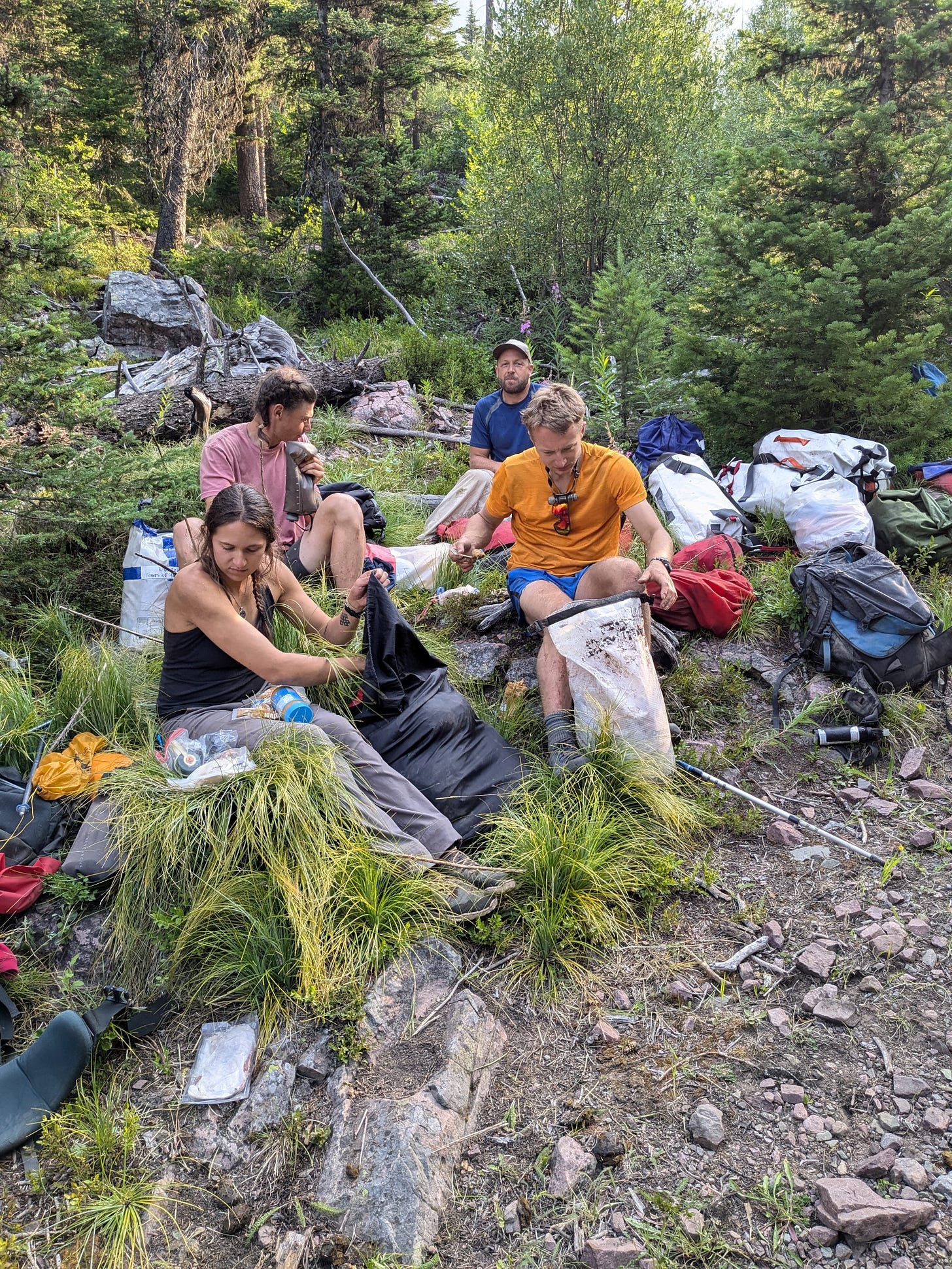
Others were not so lucky. Several people had some of their food soaked in creek water and/or mule blood overnight and had to ditch it. Irina had it the worst—a large portion of her food was soaked and destroyed, and she announced that she was gonna have to hike out. Enough of us told her that we had extra food that we could share that we talked her out of it. I had tons of extra dinner mix and made sure it was known that her or anyone could have plenty of mine. I had a 6 liter and a 3.6 liter Darren drum full of dinner mix, which was probably around 33 meals, conservatively, as well as 2 meals of oatmeal. For 2 weeks I only needed 28 dinner/breakfast meals, so I had a good amount to spare. I was less sure about the quantities of food involved for my day food, as I just eyeballed that, but I brought a lot and would be fine sharing some. Irina also had some parts of her vertical gear damaged via crushing force, but Jason had spares in the relevant pieces of gear that he loaned her.
The packers were amazed that we had been able to fix the mess so effectively and so quickly. We could tell that they were a little shell-shocked when we first got to them this morning, so we quickly took over the operation and made our own plans and teams to get the cleanup done. They were grateful that we were able to get 3 of their mules back to the trail, as they are quite expensive. Grown and trained pack mules cost around $15,000. They had just lost 2 of them, and were at least thankful that they wouldn’t lose the other 3 due to our getting them back to the trail in a timely manner. We thought they were gonna turn around and head home after they retrieved their remaining live mules, but to our surprise they told us they would get all our gear to Pagoda Pass by noon the next day. Just 2 days behind schedule.
Now it was time for some planning about schedule changing (something that would happen frequently in the upcoming days). Our default option was the expedition as planned just on a 2 day delay. This option was not bad, but it would mean we would probably have to can the second stay at the yet-to-be-established camp 2 in the cave. One no-brainer option we could do to gain an extra day would be to carry the caving gear and food to basecamp today for those on the first scheduled trip in the cave. This would let the first scheduled trip go in the cave today, only one day late, instead of tomorrow after the mules brought their gear to Pagoda Pass. See the original planned schedule below if this doesn’t make sense.
Today was July 23. The first team scheduled to enter the cave was “Setup Team” on July 22, to haul sleeping bags and other camp gear to camp 1 in the cave and set it all up. That trip had to happen and was not something we could cancel. We decided to carry the gear of the 4 people on that team to basecamp today, so they could enter the cave later in the afternoon and start their trip only 1 day behind schedule. I grabbed one of the loaded camp packs with supplies for camp 1, and Pete’s vertical gear (he was on that setup team), and my own food bag, and packed it all in my backpack so I could bring it back to basecamp.
The “Lower Rig Team” was supposed to do a 2 day trip that would enter the cave, go below camp 1, fix a bunch of bad rigging there, then return to camp 1 on day 1; and exit the cave on day 2. The reason for this trip was that much of the cave between camp 1 and the site planned for camp 2 had horrible, unsafe rigging. There were many exposed stemming traverses without any floor visible below you as you stem above the void, and without ropes for safety. And there were some traverses like that that had very minimal, loose rigging that did not offer much safety. The rigging or lack thereof in these places got the job done in past years when we only went through these places with day packs, not camp gear. But this year when people would be going through there loaded down with heavy camp packs, we thought it was just too unsafe.
Another reason we wanted to beef up the rigging between camps 1 and 2 is that the travel through some of these spots got more difficult over the years as it gets tracked up with mud. Some of the traverses were fine without ropes when they were clean and dry. But as more cavers track mud through there from other parts of the cave that are extremely muddy, the stemming gets slick and insecure. Exposed stemming high above the out-of-sight floor without safety ropes is one thing when you’re stemming on dry rock, but when you’re on slick muddy rock, it’s even less of a good idea.
We decided to cancel the trip to beef up the rigging there before Push Team A came through with heavy camp packs. This would allow Push Team A, which would establish camp 2 and do the first exploration of the expedition, to start their trip on schedule, tomorrow. I was fine with this change, as I had been through this section before and found it a little hairy but generally fine. I would certainly be OK going through there with heavier, bigger camp packs instead of the lighter day packs I had carried through there before.
Still, I found it a little disconcerting that we were cancelling this trip for the following reason. 2 years ago, at the end of the 2024 expedition when we were discussing the possibility of setting up camp 2 in the planned spot that we discovered that year, Jason asked the group whether it would be feasible to go through the terrain below camp 1 with the sketchy muddy stemming, with heavy camp packs, without major modifications to the rigging. I said yes while everyone else in the group said no. So I knew that me being comfortable hauling camp packs all the way to the proposed camp 2 site is not something that we should necessarily expect of everyone else.
Still, that was the decision we made. We decided that “Mud Camp Team A” would take over the rigging work that was planned for Lower Rig Team, so that Push Team B would get the benefit of the better rigging, as would Push Team A when exiting the cave. This would mean that Mud Camp Team A wouldn’t get to do any survey at the bottom of the cave as originally planned, but that was the tradeoff we would take to get both Push Teams A and B going in the cave on time and therefore with there full allotted time for exploration.
At least, this plan is what ended up happening. I know the planned schedule changed several times in the next 2 days, and I forget exactly what the intermediate plans were and when they were hatched. This was the final plan that we had settled on by the time that the relevant teams were going in the cave.
With our new plan hatched, my bag loaded down with gear for people caving today, and the mule packers dedicated to getting us the rest of our gear tomorrow, we set off from the site of the wreck to basecamp. Dustin and I offered to take handsaws from the packers and cut away brush on the Helen Creek trail to make their job easier tomorrow. The trail gets very little use and is generally quite overgrown. Mules can generally handle brushy, overgrown trail just fine, but after the accident we wanted to make the trail as nice as possible. So Dustin and I set off with our saws, stopping every few minutes to cut away brush and letting everyone else pass us as we worked.
Cutting brush ended up being much more work than we thought. Much of the brush was thick and woody and had likely been growing over the trail for several years. Back in the 2024 expedition we ran into a forest service trail crew doing work on the Helen Creek trail, so I know it gets maintained occasionally, but I wouldn’t be surprised if it hadn’t gotten any maintenance since then. Once Dustin and I started working, the cool morning temps were gone and we were baking in the same 90’s-and-sunny heat we were familiar with from the previous few days. The sun was especially harsh as most of our work was above the part of the trail with denser vegetation and shade, and we worked through high noon. We now knew we were both caving tomorrow, so we made sure to drink plenty of water to stay hydrated in order to be ready for a long hard day the next day.
After several hours of work, the Helen Creek trail above the site of the wreck was totally clear of brush and we were quite proud of our work. I could tell that all that labor in the heat had taken a lot out of me, and I was ready to be in a 37 degree cold wet muddy cave instead. Still, Dustin and I were proud of the job we did and of how much easier the trail would be for the packers the next day.
When we were partway up the trail and still cutting brush, Jason passed us after spending some time talking with the packers and some forest service employees who had hiked in. Jason told us that the trail was noticeably better and that we were doing great work. He also told us some bad news: that the forest service was closing the Helen Creek trail due to grizzly bear danger from the mule carcasses. We would finish our day on the trail and the packers would take our stuff up on it tomorrow, but after that they would close the trail for several weeks or until they could dispose of the carcasses.
The Bob Marshall Wilderness in northern Montana has the highest number of grizzly bears (the dangerous ones, unlike black bears which are much more common and much less dangerous) anywhere in the lower 48 in the US. Grizzlies have very sensitive smell, and they were very likely to smell the mule carcasses as they started to fester and decay, especially in this heat. The forest service told Jason, and he told us, that their peak smelliness would likely come after the carcasses bloated then exploded, which would take about 2 weeks. 2 weeks was when we were planning on hiking out down that trail, and was now when there was the highest probability of running into a grizzly bear on the trail. Grizzly bears fiercely defend their food stashes, and they would likely smell us if several (smelly, not-recently-showered) humans came down the trail and passed a few hundred feet from the carcasses. Thus if we hiked out on our planned route in 2 weeks, we were quite likely to get attacked by a grizzly bear fiercely defending its food stash, at least according to the forest service. Hence their decision to close the trail after tomorrow and recommend we take a different way out. They recommended an alternate route to Jason that we would take. This alternate route was an abandoned, unmaintained trail that followed the ridge south of Helen Creek. They didn’t know what kind of shape this former trail was in, but they said it should be passable, if less pleasant than Helen Creek. Oh well, complication number…??… of the expedition. I had lost count.
Dustin and I were the last of the group to get back to basecamp, around mid-afternoon. The first haul team was planning on entering the cave later that afternoon. I volunteered to carry some of their gear to the entrance, so save them a little bit of effort before their long in-cave hauling effort they would face tonight. Thankfully I had a little bit of time to make some food and relax a little bit before getting back into work mode. Because Pete (who was on this haul team) had some extra space in his pack, he volunteered to haul a small amount of gear to camp 1 for Push Team A (which I was one). I gave him a 2 pound block of cheddar cheese and thanked him profusely for taking that to camp 1 for us.
A bunch of us hiked over to the entrance carrying gear for the haul team around 4pm. Hans’ high schoolers also came, as they were planning on going in the cave just a little bit, to the first rope, to get some sense for what it was like. After yet another hot, sweaty hike to the entrance, we all took a group photo of the first group entering the cave this year. The haul team entered the cave, and shortly after, the high schoolers. The expedition was officially back on track.
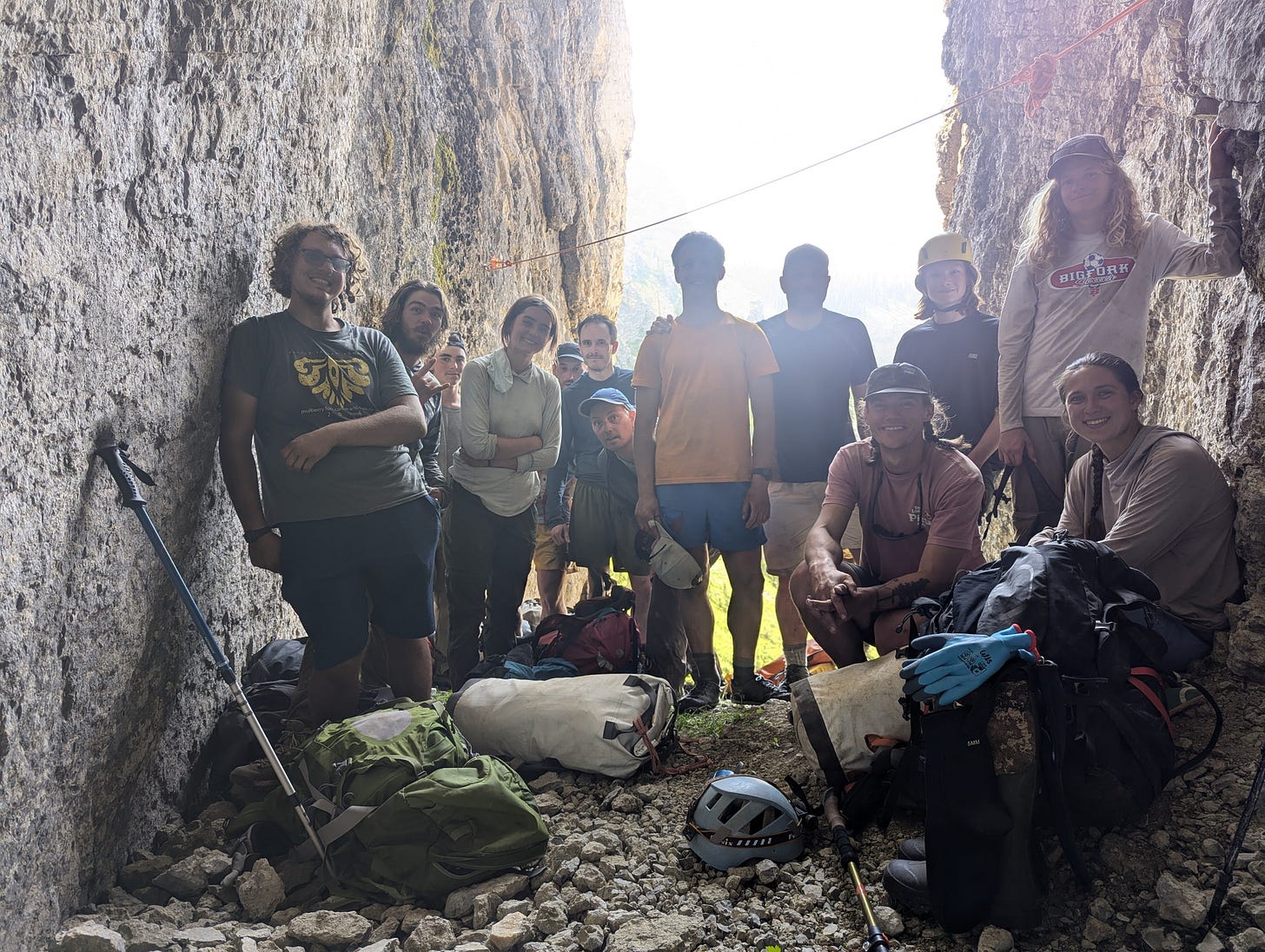

I hiked back to basecamp and spent the rest of the evening resting and thinking about what a crazy day it had been. I woke up at 4 in the morning, cleaned up a mule wreck including burrowing in between some mule carcasses, did some major trail work, and made it back in time to bring gear to the cave entrance for a team going all the way to camp 1. The team going to camp 1 had an especially long day, and theirs would not be over for several more hours. Tomorrow would be a smaller, but still substantial day for me, as I would haul a few loads between Pagoda Pass and basecamp then haul some more gear to camp 1. We made a fire at camp that night and basked in the glory of our successful day for a little while before going to bed relatively early.
Wednesday, July 24th: Pagoda Pass hauling, and in the cave to camp 1
The packers were right on time at Pagoda Pass at noon. I did 2 laps hauling heavy loads (probably around 60 pounds) from Pagoda Pass to basecamp. The heat and sun were as strong as ever, but at least today I had the luxury of carrying the heavy loads mostly downhill and going back uphill with an empty pack. The route between the pass gains about 300 ft and loses about 800 ft of elevation, all off-trail. I also had the luxury of knowing that soon I would be in a cold, dark wet cave, out of the sun (where I would probably soon miss the scorching heat anyways).
After my 2 laps between the pass and basecamp, I loaded up on food in preparation for my trip to camp 1 in the cave later today, and started packing my cave bag. Jason decided that the 4th person on our Push Team A would be Derek Von Nieda. So the team would be Dustin, Tommy, Derek, and I. I had never caved with Derek, and had never met him before him and Hans picked me up at the airport on Friday, so I was looking forward to getting to know him. The 4 of us packed our camp bags together, taking group gear we would all need for our trip from a pile and distributing it among our bags. With all our food for our scheduled 7 day camp trip in our bags, we had no space for all the group gear we would need. This was a problem.
First we of course unpacked and repacked our cave packs several times, each time fitting a little more stuff in them. But we never came close to getting all the personal gear (food, extra clothes) and group gear (rope, survey equipment, sleeping bags and sleeping pads) we needed into the cave bags. This led to us changing the plan yet again. Push Team A (me and 3 others) would take only 2 days worth of food down to camp 1 then camp 2 the next day. Mud Camp Team A, entering the next day, would take our remaining food, and some extra rope, and bring it to camp 1 then halfway between camps 1 and 2 on that first day or their trip which would also be the second day of our trip. On the second day of our trip, after we reached camp 2, we would head back towards camp 1 and meet Mud Camp Team A halfway between camps 1 and 2. There we would pick up the gear and haul it down to camp 2, where we would then have all the food and gear necessary for our 7 day trip.
With yet another schedule change solidified, we packed the subset of our personal gear and group gear that we would need, and headed to the cave. Just like I did yesterday, we had some of the others still on the surface haul some of our gear to the entrance for us, to save us just a little bit of effort. This was the first expedition that we had ever gone caving on the same day that we hauled gear from Pagoda Pass. Our Push Team A was doing this today, and the Setup Team yesterday did something similar and even harder when they went to camp 1 the same day they cleaned up the mule wreck.

I was trying a slightly unconventional and bold cave suit strategy this year, and I was eager to see how my choice would work out. The standard choice of cave suit for Tears is one made out of a fully waterproof, non-breathable fabric like PVC or TPU. These suits are appropriate for the wettest, coldest caves, because they keep all water from getting through the fabric. This also means that you get soaked from your own sweat when working hard, as none of your own moisture can work its way outside the suit. This tradeoff is worth it for very cold, wet caves, as you’re gonna get wet from something anyways, and you’d rather it be from your own sweat than frigid cave water.
Nylon suits, in contrast, are only moderately water-resistant, and they are moderately breathable, meaning water inside the suit from your own sweat or otherwise can work its way outside via evaporation and diffusion through the suit fabric. These suits are better for caves that aren’t too wet, as you can dry out the interior over time, which makes you more comfortable, and possibly warmer if you stop and generate less body heat in a not-too-wet section of cave.
Most people wear PVC or TPU suits in Tears, such as the yellow PVC suits you can see above, but this year a few brave souls were trying nylon. Pete and I were rocking nylon suits on our long camp trips. You can see my orange nylon Landjoff suit above. Adrian also had a nylon suit, but he wasn’t planning on going below camp 1, where there’s wet, slimy, sticky, sloppy mud that chills you to the bone and makes travel difficult in so many other ways that make the cave infamous. The idea was that this year it might make sense to switch to nylon since we were camping below the slimy mud layer for the first time. Instead of commuting through the slime below camp 1 every day in order to get to the bottom of the cave where there was exploration to be done, this year each exploration team would only pass through the slime once on the way to camp 2 and once on the way out of the cave. So we opted to made a trade that made for a colder, less pleasant trip between camps 1 and 2 but hopefully for a warmer, more pleasant time below camp 2, which was drier and not muddy at least as far as we had gotten last year.
Of course, we had no idea whether the cave below camp 2 would remain dry(-ish) and free of mud. We had only explored about 20 minutes beyond camp 2, and we had truly no idea what lie beyond. That 20 minutes of travel was a slightly narrow but really “tight” sideways walking canyon with a stream in the floor, and walls that were damp but clean-washed and not muddy. It was blissful in comparison to the nasty tight series of squeezes fully of wet slimy mud that characterized the cave above camp 2. But the cave could easily change character beyond what we explored 2 years ago, and me and Pete were both taking a gamble that the cave would remain appropriate for nylon suits beyond the current frontier of exploration.
Either way, nylon suits were better suited for the cave above camp 1. That’s before the serious mud hits you, so you don’t get too wet from the cave. And now that all anyone does in that section of the cave is move fast and haul heavy bags, it’s rare to get cold in that section, so cooler, more breathable suits are best. I would see if nylon was a good choice when going through the slime below camp 1 and when exploring new cave beyond camp 2.
The part of the cave above camp 1 can be divided into 2 sections. The second half, closer to camp 1, is called the Bunga Bunga Meanders. We don’t have a name for the half above the Bunga Bunga, we’ll just call it the upper part of the cave. Travel time from the entrance to camp 1 generally takes 5-8 hours, depending on the group’s fitness and how heavy their bags are. In 2022, our team took 7.5 hours on the way down, as most of us were new to the cave and we tried to avoid getting sweaty/wet, by going slow. We then took 5.5 hours on the way out, even though we were going up instead of down, as we had smaller, lighter bags and we didn’t care so much about sweating and getting soaked. I was curious how my time this year would compare to summer 2022. I expected it to be a bit slower, because now I had a desk job instead of being a funemployed dirtbag that had been doing nothing but hard labor and cardio for months in a row.
How did the actual caving part of this expedition go? Did we get tons of amazing exploration done, and push the cave deeper? Or was it full of mishaps, as the trip had been so far? All that will be in the next post—subscribe and wait and see to find out what happens!

